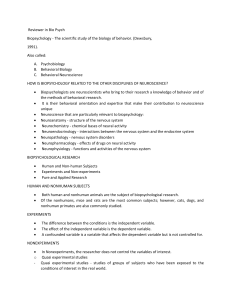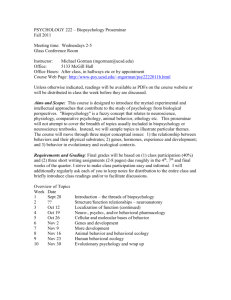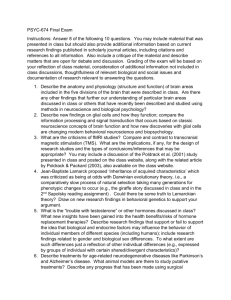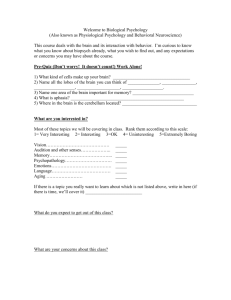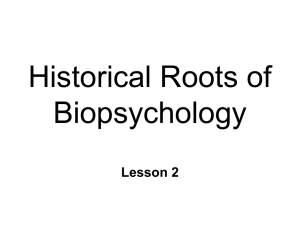biopsychology as a neuroscience
advertisement
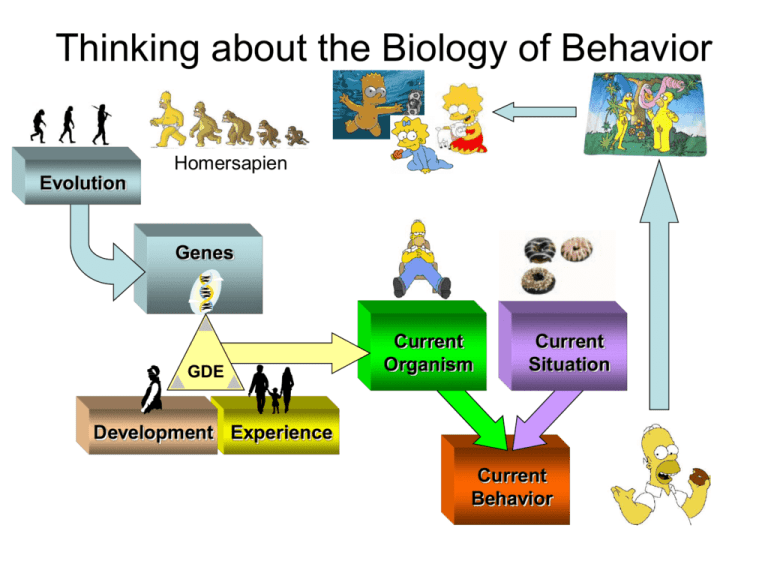
Thinking about the Biology of Behavior Homersapien Evolution Genes GDE Current Organism Current Situation Development Experience Current Behavior Biopsychology – the scientific study of the biology of behavior (Dewsbury, 1991). • Psychobiology • Behavioral biology • Behavioral neuroscience • Physiological psychology It denotes a biological approach to the study of psychology (the scientific study of behavior). “Although it is not possible to specify the exact date of biopsychology’s birth, the publication of The Organization of Behavior in 1949 by Donald Hebb played a key role in it’s emergence.” Biopsychology is an integrative discipline of neuroscience • Neuroanatomy – structure of the nervous system • Neurochemistry – chemical basis of neural activity • Neuroendocrinology – interactions between the nervous system and the endocrine system • Neuropathology – nervous system disorders • Neuropharmacology – effects of drugs on neural activity • Neurophysiology – functions and activities of the nervous system Research Dimensions of Biopsychology • Human and Nonhuman Subjects • Experiments and Nonexperiments • Pure and Applied Research Advantages of using Human Subjects: • Follow instructions • Report subjective experiences • Cost effective • Human brains Evolutionary continuity Qualitatively similar but quantitatively different Sphere Surface Area = 4 • π • r² Sphere Volume = 4/3 • π • r³ Brain with a medial-lateral (M-L) radius of 2 cm (rat): surface area = 4 x 3.14 x 4 = 50.24 volume= (1.33x3.14) 4.1866 x (23) 8 = 33.49 surface area/volume ratio = 1.50 Brain with a M-L radius of 6.5 cm (human): surface area = 4 x 3.14 x 42.25 = 530.66 volume= (1.33x3.14) 4.1866 x (6.53) 274.625 = 1149.76 surface area/volume ratio = 0.46 Advantages of using Animal Subjects: • Simple systems approach • Comparative approach • Ethical reasons • Pre-clinical research Symphonic inspiration http://www.pbs.org/wgbh/nova/sciencenow/0304/01.html Animal Research and Disease Research Designs Used in Biopsychology • Experimental studies • Quasi-experimental studies • Case studies Experimental studies • Establish cause effect relations • Essential to scientific discovery • Are paradoxically very simple Elements of the Experiment • Two or more conditions • Between- or within-subjects design • Independent variable • Dependent variable Example of an Experiment based on the Coolidge effect The story: President Calvin Coolidge and his wife were visiting a poultry farm. The first lady asked the farmer how so many eggs were produced with only a few roosters around. The farmer answered “each roosters performs his duty dozens of times each day.” The first lady said “perhaps you should point that out to the president…” Example of an Experiment based on the Coolidge effect The story continued… Then President Coolidge said, “But does each rooster service the same hen?” The farmer replied “No, there are many hens for each rooster.” “Perhaps you could point that out to Mrs. Coolidge,” replied the President. Example of an Experiment Lester & Gorzalka (1988) Problem: the Coolidge effect had only been demonstrated in males (hamsters); attempts with females were unsuccessful. Hypothesis: Studies with females were confounded by the fact that their male partners get fatigued so quickly. Solution: Use more male partners to compensate for the confound of male sexual fatigue. Lester & Gorzalka (1988): Experimental Design Male # 1 Female # 1 Male # 2 Female # 2 Male # 1 & 2 rest Male # 3 Female # 1 (fatigue) One of two tests were conducted Female # 1 Male # 1 (familiar) Female # 1 Male # 2 (unfamiliar) Lester & Gorzalka (1988): Experimental Design Dependent Measure: The amount of time female # 1 displayed Lordosis – rodent form of sexual receptivity indicated by an arched-back, rump-up and tail-diverted posture) Lester & Gorzalka (1988): Results: Mean Lordosis Duration (min) 35 Male 1 Male 1 30 25 20 Male 3 Male 3 15 10 Male 2 5 Male 1 0 Unfamiliar Familiar Quasiexperimental studies • Studies of groups of subjects exposed to conditions in the real world • Not real experiments as potential confounded variables have not been controlled Quasiexperimental studies • Poorly educated • Prone to accidental head injury • Likely to use other drugs • Likely to have poor diets Case studies • Case studies focus on a single individual, such as Jimmie G. • Usually more in-depth than other approaches, but may not be generalizable • Generalizability – the degree to which results can be applied to other cases Pure and Applied Studies • Pure research – conducted for the purpose of acquiring knowledge • Applied research – intended to bring about some direct benefit to humankind • Some research projects may have elements of both Divisions of Biopsychology • Six major divisions • Each has a different approach, but there is much overlap • Physiological psychology, psychopharmacology, neuropsychology, psychophysiology, cognitive neuroscience, comparative psychology Divisions of Biopsychology • Physiological psychology – Neural mechanisms of behavior – Direct manipulation of the brain • Psychopharmacology – Effects of drugs on the brain • Neuropsychology – Brain damage in humans Divisions of Biopsychology • Psychophysiology (not psychopsychology) – Relation between physiological activity and psychological processes • Cognitive neuroscience – Neural bases of cognition • Comparative psychology – Comparing different species to understand evolution, genetics, and adaptiveness of behavior THE SIX DIVISIONS OF BIOPSYCHOLOGY EXAMPLES OF HOW THE SIX APPROACHES HAVE PURSUED THE STUDY OF MEMORY Physiological psychology: study of the neural mechanisms of behavior by manipulating the nervous system of nonhuman animals in controlled experiments. Physiological psychologists have studied the contributions of the hippocampus to memory by surgically removing the hippocampus in rats and assessing their ability to perform various memory tasks. Psychopharmacology: study of the effects of drugs on the brain and behavior. Psychopharmacologists have tried to improve the memory of Alzheimer’s patients by administering drugs that increase the levels of the neurotransmitter acetylcholine. Neuropsychology: study of the psychological effects of brain damage in human patients. Neuropsychologists have shown that patients with alcoholproduced brain damage have particular difficulty in remembering recent events. Psychophysiology: study of the relation between physiological activity and psychological processes in human subjects by noninvasive physiological recording. Psychophysiologists have shown that familiar faces elicit the usual changes in autonomic nervous system activity even when patients with brain damage report that they do not recognize a face. Cognitive neuroscience: study of the neural mechanisms of human cognition, largely through the use of functional brain imaging. Cognitive neuroscientists have used brain-imaging technology to observe the changes that occur in various parts of the brain while human volunteers perform memory tasks. Comparative psychology: study of the evolution, genetics, and adaptiveness of behavior, largely through the use of the comparative method. Comparative psychologists have shown that species of birds that cache their seeds tend to have big hippocampi, thus confirming that the hippocampus is involved in memory for location. Converging Operations Using multiple approaches to address a single question • Korsakoff’s syndrome – a condition characterized by severe memory loss and most commonly seen in alcoholics • Is Korsakoff’s the result of the toxic effects of alcohol on the brain? Converging Operations • Case studies: – Jimmie G. – an alcoholic with Korsakoff’s – Korsakoff’s is also seen in malnourished persons who had little or no alcohol • Experiments: – Thiamine-deficient rats exhibit memory deficits – Alcohol accelerates the development of brain-damage in thiamine-deficient rats Converging Operations • Korsakoff’s syndrome is the result of thiamine deficiency, but the damage is accelerated by alcohol • By exploring the possible causes of Korsakoff’s using multiple approaches (converging operations) stronger conclusions can be reached.
